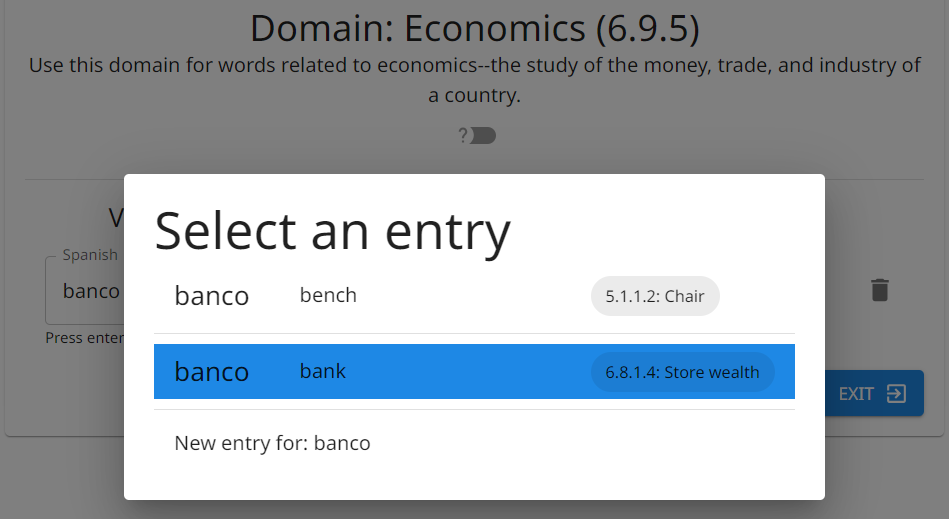Data Entry
Semantic Domain Tree
Browse or search for the domain of interest.
Tip
To make searching for a domain quicker, The Combine will automatically insert . between consecutive digits as you
type. For example, 1234 will automatically become 1.2.3.4. This behavior does not happen if any non-numeric
characters are entered.
New Entry
Vernacular
A word as found in the vernacular language, usually spelled either phonetically or with the local orthography.
Gloss
While an entry can have multiple senses/glosses, only one can be added when the entry is first created.
Note
You can have one note on each entry. Any annotation for an entry's senses, glosses, semantic domains, etc. can be added to the entry's note.
Recording
You can add multiple recordings to an entry (e.g., a male voice and a female voice). As with the note, audio recordings are associated with the entry and not individual senses.
To record audio, there is a red circle button. For each recorded audio, there is a green triangle button.
With a mouse: Click-and-hold the red circle to record. Click a green triangle to play its audio, or shift click to delete its recording.
On a touch screen: Press-and-hold the red circle to record. Tap a green triangle to play its audio, or press-and-hold to bring up a menu with options.
Add a speaker to audio recordings
Click the speaker icon in the top bar to see a list of all available speakers and select the current speaker. This speaker will be automatically associated with every audio recording until you log out or select a different speaker.
The speaker associated with a recording can be seen by hovering over its play icon, the green triangle. To change a recording's speaker, right click the green triangle (or press-and-hold on a touch screen).
Note
Imported audio cannot be deleted or have a speaker added.
New Entry with Duplicate Vernacular Form
If you submit a new entry with identical vernacular form and gloss to an existing entry, that entry will be updated instead of a new entry created. For example, if you submit [Vernacular: dedo; Gloss: finger] in domain 2.1.3.1 (Arm) and again in domain 2.1.3.3 (Finger, Toe), the result will be a single entry for "dedo" with a single sense that has gloss "finger" and two domains.
The Combine has an optional feature to facilitate entry of words that already exist in the project but which are collected again in a new semantic domain. This feature can be turned on or off in Project Settings > Autocomplete. When the setting is on, as you type the vernacular form in Data Entry, a drop-down menu appears with identical/similar vernacular forms that already exist as entries in the project. If you see that the word you are typing is already in the project, you can click on the word in the list of suggestions, instead of having to typing the remainder of the word. When the setting is off, the vernacular word must be typed in its entirety; no existing potential matches will be suggested.

Whether you type a form that matches an existing entry in the project or select one of the suggestions offered by The Combine, a box will pop up with options. (This box will not pop up if the Autocomplete setting is off or if you type a vernacular form that does not yet exist in the project.) In the pop-up box, you will be shown all existing entries with that vernacular form and can to choose whether to update one of those entries or create a new entry.

If you choose to create a new entry, the pop-up box will close, and you can then type the gloss for your new entry.
Note
Even if you selected to create a new entry, if the gloss you type is identical to a gloss of another entry with the same vernacular form, a new entry will not be created, but rather that entry will be updated.
If you instead choose to update one of the existing entries, more options will appear to update an existing sense on the selected entry or to add a new sense to that entry.